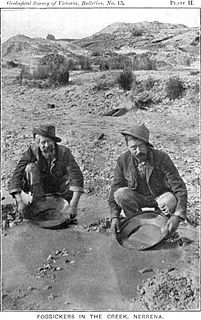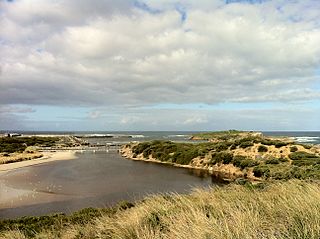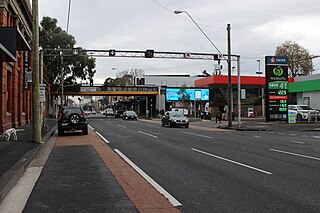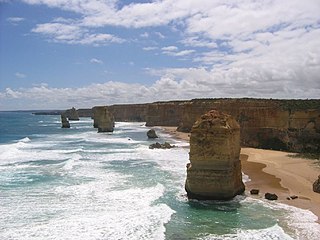Related Research Articles

The Eureka Rebellion occurred in 1854, instigated by gold miners in Ballarat, Victoria, Australia, who revolted against the colonial authority of the United Kingdom. It culminated in the Battle of the Eureka Stockade, which was fought between rebels and the colonial forces of Australia on 3 December 1854 at Eureka Lead and named after a stockade structure built by miners in the lead-up to the conflict. The rebellion resulted in at least 27 deaths and many injuries, the majority of casualties being rebels.

The Victorian gold rush was a period in the history of Victoria, Australia approximately between 1851 and the late 1860s. It led to a period of extreme prosperity for the Australian colony, and an influx of population growth and financial capital for Melbourne, which was dubbed "Marvellous Melbourne" as a result of the procurement of wealth.

George Augustus Robinson was a British-born colonial official and self-trained preacher in colonial Australia. In 1824, Robinson travelled to Hobart, Van Diemen’s Land, where he attempted to negotiate a peace between European settlers and Aboriginal Tasmanians prior to the outbreak of the Black War. He was appointed Chief Protector of Aborigines by the Aboriginal Protection Board in Port Phillip District, New South Wales in 1839, a position he held until 1849.

Warrnambool is a city on the south-western coast of Victoria, Australia. At June 2016, Warrnambool had an estimated urban population of 35,214. Situated on the Princes Highway, Warrnambool (Allansford) marks the western end of the Great Ocean Road and the southern end of the Hopkins Highway.

Abbotsford is an inner-city suburb of Melbourne, Australia, 2 kilometres (1.2 mi) north-east of Melbourne's Central Business District. Its local government area is the City of Yarra. At the 2016 census, Abbotsford had a population of 8,184.

Apollo Bay is a coastal town in southwestern Victoria, Australia. It is situated on the eastern side of Cape Otway, along the edge of the Barham River and on the Great Ocean Road, in the Colac Otway Shire. The town had a population of 1,598 at the 2016 census.

The Western District comprises western regions of the Australian state of Victoria. It is said to be an ill–defined district, sometimes incorrectly referred to as an economic region,. The district is located within parts of the Barwon South West and the Grampians regions; extending from the south-west corner of the state to Ballarat in the east and as far north as Ararat. The district is bounded by the Wimmera district in the north, by the Goldfields district in the east, by Bass Strait and the Southern Ocean in the south, and by the South Australian border in the west. The district is well known for the production of wool. The most populated city in the Western District is the Ballarat region, with 96,940 inhabitants.
The Boonwurrung, are an Aboriginal people of the Kulin nation, who reside from Werribee River to Wilsons Prom, Victoria, Australia, including part of what is now the city and suburbs of Melbourne. Before British colonisation, they lived as all people of the Kulin nation lived, sustainably on the land, for tens of thousands of years. They were called the Western Port or Port Philip tribe by the early settlers, and were in alliance with other tribes in the Kulin nation, having particularly strong ties to the Wurundjeri people.

The Taungurung people, also spelt Daung Wurrung, consisted of nine clans who spoke the Taungurung language and were part of the Kulin alliance of indigenous Australians. They lived to the north of, and were closely associated with, the Woiwurrung speaking Wurundjeri people. Their territory is to the north of the Great Dividing Range in the watersheds of the Broken, Delatite, Coliban, Goulburn and Campaspe Rivers. They were also known by white settlers as the Devil's River Tribe or Goulburn River Tribe.

Alberton is a small town in Victoria, Australia. It is located along the South Gippsland Highway, 7 kilometres south of Yarram and 216 kilometres east of Melbourne. Albert River passes through the town. At the 2006 census, Alberton had a population of 162.
The Wathaurong nation, also called the Wathaurung,Wadawurrung and Wadda Wurrung, are an Aboriginal Australian people living in the area near Melbourne, Geelong and the Bellarine Peninsula in the state of Victoria. They are part of the Kulin alliance. The Wathaurong language was spoken by 25 clans south of the Werribee River and the Bellarine Peninsula to Streatham. The area they inhabit has been occupied for at least the last 25,000 years.

Lake Bolac is a town in the Western District region of Victoria, Australia. The town is on the shores of Lake Bolac, and the Glenelg Highway passes through the town. At the 2016 census, Lake Bolac and the surrounding area had a population of 330.

Victoria is a state in southeastern Australia. It is the second-smallest state with a land area of 227,444 km2 (87,817 sq mi) and the most densely populated state in Australia. Victoria is bordered with New South Wales to the north and South Australia to the west, and is bounded by the Bass Strait to the south, the Great Australian Bight portion of the Southern Ocean to the southwest, and the Tasman Sea to the southeast. The state encompasses a range of climates and geographical features from its temperate coastal and central regions to the Victorian Alps in the north-east and the semi-arid north-west.
Ebenezer Mission, also known as Wimmera mission, Hindmarsh mission and Dimboola mission, was a mission station for Aboriginal people established near Lake Hindmarsh in Victoria, Australia in 1859 by the Moravian Church on the land of the Wotjobaluk. The first missionaries were two Germans, Reverend Friedrich Hagenauer and Reverend F.W. Spieseke. In 1861 the Victorian Colonial Government gazetted 1,897 acres (7.68 km2) as a reserve for the Ebenezer Mission Station. The mission was established a few years after the failure of the Moravian Lake Boga mission in Wemba-Wemba territory.
The Convincing Ground Massacre was a massacre of the Indigenous Gunditjmara people Kilcarer gundidj clan by British settler whalers based at Portland Bay in South-Eastern Australia. It was part of the wider Eumeralla Wars between the British colonisers and Gunditjmara. Tensions between the two groups had been building since the establishment of the town as a whaling station some five years previously, however, around 1833 or 1834, a dispute over a beached whale caused events to escalate.
The Gulidjan people, also known as the Kolakngat, or Colac tribe, are an Aboriginal Australian tribe whose traditional lands cover the Lake Colac region of the state of Victoria, Australia. They occupied the grasslands, woodlands, volcanic plains and lakes region east of Lake Corangamite, west of the Barwon River and north of the Otway Ranges. Their territory bordered the Wathaurong to the north, Djargurd Wurrung to the west, Girai Wurrung to the south-west, and Gadubanud to the south-east.
The Yalukit or Yalukit-willam people are a constituent clan of the Boonwurrung peoples. The Yalukit are the earliest Aboriginal inhabitants of the central bay-side region of Melbourne (Birrarung-ga). The Yalukit have inhabited the central bay-side areas of Melbourne for thousands of years.

Aboriginal Victorians, the Aboriginal Australians of Victoria, Australia, occupied the land for tens of thousands of years prior to European settlement. Aboriginal people have lived a semi-nomadic existence of fishing, hunting and gathering, and farming eels in Victoria for at least 40,000 years.

The Avon River, an inland intermittent river of the Wimmera catchment, located in the Grampians and Wimmera regions of the Australian state of Victoria. Rising on the northern slopes of the Great Dividing Range, the Avon River flows north-westerly to reach its confluence with the Richardson River. The rivers of the Wimmera catchment drain into a series of ephemeral lakes that, whilst they do not directly empty into a defined watercourse, they form part of the Murray River catchment of the Murray-Darling basin.
Criminal activity in Victoria, Australia is combated by the Victoria Police and the Victorian court system, while statistics about crime are managed by the Crime Statistics Agency. Modern Australian states and cities, including Victoria, have some of the lowest crime rates recorded globally with Australia ranked the 13th safest nation and Melbourne ranked the 5th safest city globally. As of September 2018 the CBD of Melbourne had the highest rate of overall criminal incidents in the state (15,949.9), followed by Latrobe (12,896.1) and Yarra (11,119.2). Rural areas have comparatively high crime rates, with towns such as Mildura (9,222.0) and Greater Shepparton (9,111.8) having some of the highest crime rates in the state.
References
- 1 2 University of Ballarat School of Business Prof Ian Clark Archived 11 April 2015 at the Wayback Machine Staff Profile. Accessed 21 July 2012
- ↑ Australian Map Circle 33rd Annual Conference, 2005, Programme and Abstracts . Accessed 1 November 2011
- ↑ AIATSIS Seminar Series, Old Names, New Purposes: Reflections on Recent Indigenous Naming Policies & Programs Archived 8 June 2012 at the Wayback Machine , Canberra 2011. Accessed 1 November 2011
- ↑ Ian D. Clark, Another Side of Eureka – the Aboriginal presence on the Ballarat goldfields in 1854 – Were Aboriginal people involved in the Eureka rebellion? , Heretic Press, working paper 2005/2007, accessed 1 November 2011
- ↑ National Library of Australia, Resources for Ian D. Clark , Trove archive. Accessed 1 November 2011
- ↑ For a full list of academic research by Ian D. Clark see Centre for Regional Innovation and Competitiveness, Research Output of Dr Ian Clark Archived 4 April 2012 at the Wayback Machine , Accessed 1 November 2011